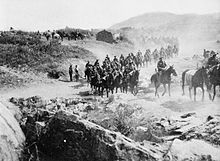| British Salonika Force British Salonika Army | |
|---|---|
 An officer of the British Salonika Army demonstrating how to throw a Mills bomb | |
| Active | World War I |
| Country | |
| Branch | |
| Type | Field army |
The British Salonika Army was a field army of the British Army during World War I. After the armistice in November 1918, it was disbanded, but component units became the newly formed Army of the Black Sea, and General Milne remained in command. [1]

